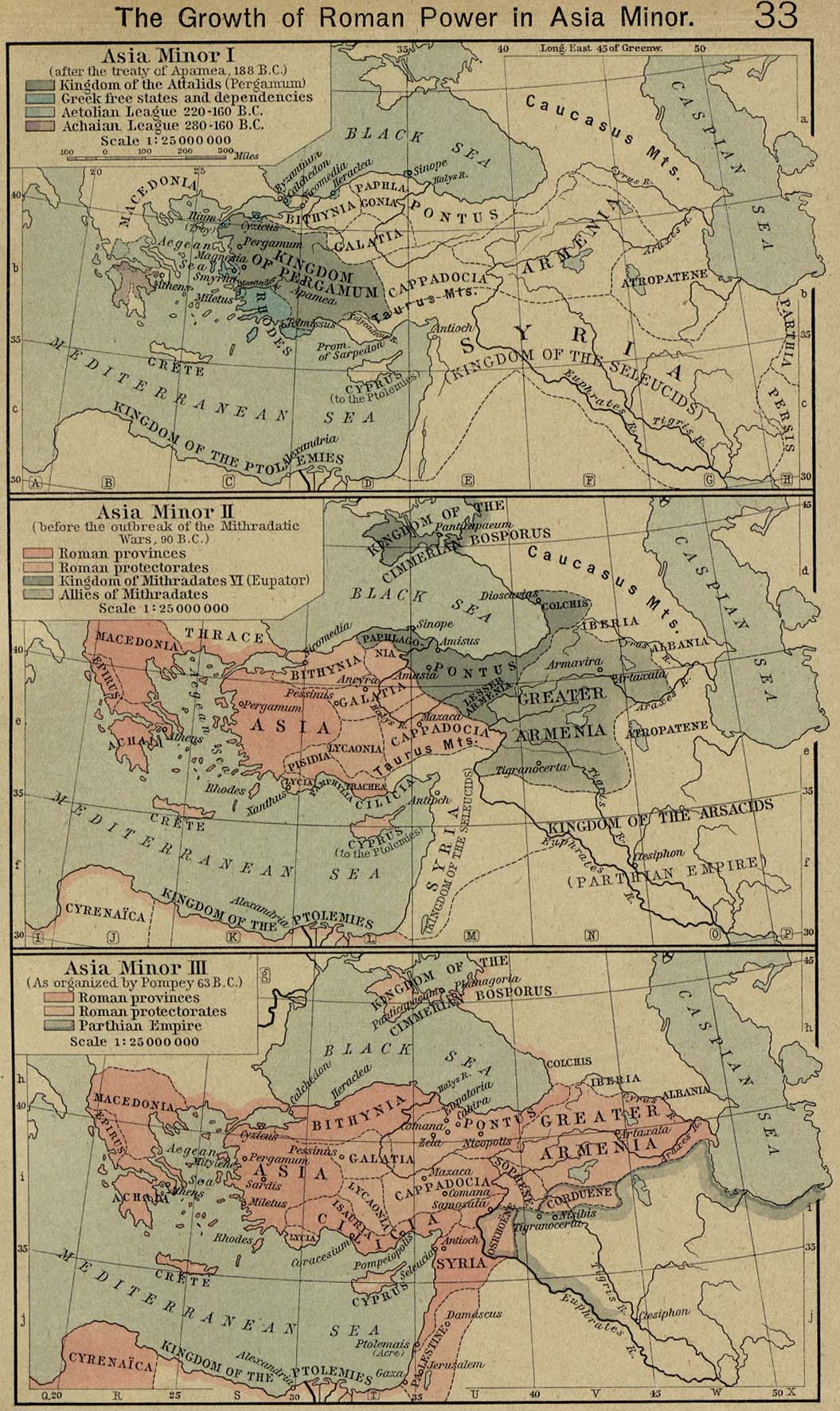Syria
After Alexander's death in 323 BC his marshals contended for control of Syria until, after the Battle of Ipsus (301), Seleucus I (Nicator) gained the northern part and Ptolemy I (Soter) gained the southern (Coele Syria). This partition between the Seleucids and the Ptolemies was maintained for 100 years. Their administrative methods varied.  In the south the Ptolemies respected the existing autonomous cities, imposed a bureaucratic system on the rest of the country, and established no colonies.The Seleucids divided the north into four satrapies and founded many cities and military colonies—among them Antioch, Seleucia Pieria, Apamea, and Laodicea—drawing on European settlers. Republics replaced kings in the Phoenician coastal cities of Tyre (274 BC), Sidon, Byblus, and Aradus. Further political and cultural changes followed.
In the south the Ptolemies respected the existing autonomous cities, imposed a bureaucratic system on the rest of the country, and established no colonies.The Seleucids divided the north into four satrapies and founded many cities and military colonies—among them Antioch, Seleucia Pieria, Apamea, and Laodicea—drawing on European settlers. Republics replaced kings in the Phoenician coastal cities of Tyre (274 BC), Sidon, Byblus, and Aradus. Further political and cultural changes followed.
In 200 BC (or perhaps as late as 198) Antiochus III (the Great) defeated Ptolemy V at Panium and secured control of southern Syria, where he introduced the satrapal system. His subsequent defeat by the Romans at Magnesia (December 190 or January 189), however, resulted in the loss of both his territory in Asia Minor and his prestige, thereby fundamentally weakening the Seleucid empire, which ceased to be a Mediterranean power. Antiochus IV (Epiphanes; 175-163) stimulated the spread of Greek culture and political ideas in Syria by a policy of urbanization; increased city organization and municipal autonomy involved greater decentralization of his kingdom. His attempted Hellenization of the Jews is well known.
Under the Seleucid kings, with rival claimants to the throne and constant civil war, Syria disintegrated. In the north the Seleucids controlled little more than the areas of Antioch and Damascus. Southern Syria was partitioned by three tribal dynasties: the Ituraeans, the Jews, and the Nabateans. The country was seized later by Tigranes of Armenia (83); he ruled until his defeat by Pompey, who ended years of anarchy by making Syria a Roman province (64-63).
Pompey in the main accepted the status quo, but he reestablished a number of cities and reduced the kingdom of Judaea; 10 cities of the interior formed a league, the Decapolis. The native client kingdoms of Commagene, Ituraea, Judaea, and Nabataea were henceforth subjected to Roman Syria. Parthian invasions were thrown back in 51-50 and 40-39 BC, and Mark Antony's extensive territorial gifts to Cleopatra (Ituraea, Damascus, Coele Syria, etc.) involved only temporary adjustments.
Under the early empire, Syria, which stretched northeast to the upper Euphrates and, until AD 73, included eastern Cilicia, became one of the most important provinces. Its governor, a consular legate, generally commanded four legions until AD 70. Administrative changes followed, as Rome gradually annexed the client kingdoms. Ituraea was incorporated (i.e., its territories were assigned to neighbouring cities) partly in 24 BC, partly c. AD 93. Judaea became a separate province in AD 6, governed by procurators (apart from the short-lived control by Agrippa I, AD 41-44), until the destruction of Jerusalem in 70. Then, the governor was a praetorian legate in command of a legion; next, under Hadrian, he was a consular with two legions, and the province was named Syria Palaestina. Commagene was annexed permanently by Vespasian in 72. The caravan city of Palmyra came under Roman control, possibly during Tiberius' reign. Finally, Nabataea was made the province of Arabia in 105, governed by a praetorian legate with one legion.
Syria itself was later divided by Septimius Severus into two provinces—Syria Coele in the north with two legions and Syria Phoenice with one. By the beginning of the 5th century it was subdivided into at least five provinces. The frontiers of Syria were guarded by a fortified limes system, which was thoroughly reorganized by Diocletian and his successors (particularly against cavalry attacks) and which endured until the Arab conquest; much knowledge of this system of "defense in depth" has been obtained with the aid of aerial photography.
(Encyclopedia Britannica)
 In the south the Ptolemies respected the existing autonomous cities, imposed a bureaucratic system on the rest of the country, and established no colonies.The Seleucids divided the north into four satrapies and founded many cities and military colonies—among them Antioch, Seleucia Pieria, Apamea, and Laodicea—drawing on European settlers. Republics replaced kings in the Phoenician coastal cities of Tyre (274 BC), Sidon, Byblus, and Aradus. Further political and cultural changes followed.
In the south the Ptolemies respected the existing autonomous cities, imposed a bureaucratic system on the rest of the country, and established no colonies.The Seleucids divided the north into four satrapies and founded many cities and military colonies—among them Antioch, Seleucia Pieria, Apamea, and Laodicea—drawing on European settlers. Republics replaced kings in the Phoenician coastal cities of Tyre (274 BC), Sidon, Byblus, and Aradus. Further political and cultural changes followed.